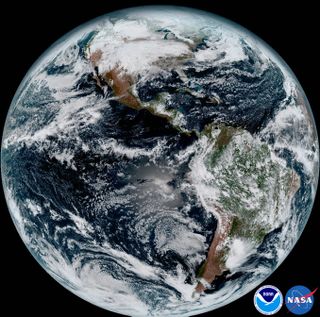White House Wants to Slash Budgets of Top Climate Science Agencies

The Trump administration's budget proposal includes a drastic 17-percent cut to the National Oceanic and Atmospheric Administration (NOAA), one of the government's top weather and climate-science agencies, according to a report by The Washington Post.
The cuts would impact both research funding and satellite programs, according to the news report.
NOAA, which is part of the Department of Commerce, is responsible for a wide range of planetary science research and monitoring "from daily weather forecasts, severe storm warnings and climate monitoring to fisheries management, coastal restoration and supporting marine commerce, according to the NOAA website. [Photos: Stunning Images of Earth from GOES-16 Weather Satellite]
The budget proposal, outlined by the Office of Management and Budget in a memo to The Washington Post, is for the fiscal year 2018 (starting Oct. 1) and proposes a cut of $126 million (26 percent of its current budget) to its research division and $513 million (22 percent of current funding) to its satellite program, called the National Environmental Satellite, Data and Information Service.
The National Marine Fisheries Service and National Weather Service, also part of NOAA, would experience 5 percent cuts under the budget proposal, according to the Post.
The National Centers for Environmental Information (NCEI) is part of the satellite program, and so would presumably experience some of the cutbacks. NCEI researchers conducted a study showing that "warming has continued at a pace similar to that of the last half of the 20th century, and the slowdown was just an illusion," they wrote in the study published in 2015 in the journal Science. The finding, which suggested there was no climate change hiatus (something that skeptics of human-caused warming have used as evidence to support their skepticism), drew harsh criticism from Republicans, including Lamar Smith, the Republican chair of the House Committee on Science, Space, and Technology.
Another NOAA program on the chopping block, Sea Grant, could be eliminated. The $73 million program funds coastal research at 33 universities across the United States, according to the Post article.
Sign up for the Live Science daily newsletter now
Get the world’s most fascinating discoveries delivered straight to your inbox.
Scientists involved with NOAA reacted to the proposed cuts. "Cutting NOAA's satellite budget will compromise NOAA's mission of keeping Americans safe from extreme weather and providing forecasts that allow businesses and citizens to make smart plans," said Jane Lubchenco, NOAA administrator under President Barack Obama, as reported by the Post. Lubchenco added that NOAA satellites provide 90 percent of the information needed for weather forecasts.
The financial cuts came from the Office of Management and Budget's so-called passback document, which asks agencies to come up with detailed budgets to submit to Congress. These numbers can change as discussions between the agencies and the White House and others evolve, according to the Post.
The passback also reportedly suggested that NOAA explore the potential for greater use of privately owned commercial satellites beginning in 2018.
NOAA isn't the only environmental agency feeling the heat. Sources told Science Insider that the administration wants to cut spending by more than 40 percent by the Environmental Protection Agency's Office of Research and Development. The cuts would reduce funding from about $510 million to $290 million, according to Science Insider.
Original article on Live Science.
Jeanna Bryner is managing editor of Scientific American. Previously she was editor in chief of Live Science and, prior to that, an editor at Scholastic's Science World magazine. Bryner has an English degree from Salisbury University, a master's degree in biogeochemistry and environmental sciences from the University of Maryland and a graduate science journalism degree from New York University. She has worked as a biologist in Florida, where she monitored wetlands and did field surveys for endangered species, including the gorgeous Florida Scrub Jay. She also received an ocean sciences journalism fellowship from the Woods Hole Oceanographic Institution. She is a firm believer that science is for everyone and that just about everything can be viewed through the lens of science.

